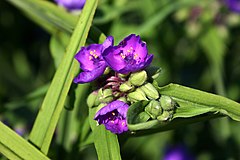Difference between revisions of "Tradescantia virginiana"
| Line 27: | Line 27: | ||
|usda_ref=Flora - A Gardener's Encyclopedia | |usda_ref=Flora - A Gardener's Encyclopedia | ||
|max_zone=10 | |max_zone=10 | ||
| − | |image= | + | |image=Dreimasterblatt BotanischerGartenMuenster 8459.jpg |
|image_width=240 | |image_width=240 | ||
}} | }} | ||
Latest revision as of 16:47, 29 April 2010
| Habit | herbaceous
| |
|---|---|---|
| Height: | ⇕ | 12 in"in" can not be assigned to a declared number type with value 12. to 20 in"in" can not be assigned to a declared number type with value 20. |
| Width: | ⇔ | 20 in"in" can not be assigned to a declared number type with value 20. to 48 in"in" can not be assigned to a declared number type with value 48. |
| Lifespan: | ⌛ | perennial |
| Bloom: | ❀ | early summer, mid summer, late summer |
| Exposure: | ☼ | part-sun |
|---|---|---|
| Features: | ✓ | flowers |
| USDA Zones: | 7 to 10 | |
| Flower features: | ❀ | red, blue, purple, pink |
Tradescantia virginiana (Virginia spiderwort) is a species of Tradescantia (spiderwort) native to the eastern United States. Spiderwort is commonly grown in gardens and many garden spiderworts seem to be hybrids of T. virginiana and other Tradescantia species.[1]
Tradescantia virginiana is a herbaceous plant with alternate, simple leaves, on tubular stems. The flowers are blue, purple, or white, borne in summer.
Read about Tradescantia virginiana in the Standard Cyclopedia of Horticulture
|
|---|
|
Tradescantia virginiana, Linn.; also spelled virginica (T. montana, Shuttlw., not Heyne. T. tumida, Lindl.). Common Spiderwort. Erect, branching, 1-3 ft., glabrous or nearly so: lvs. conduplicate, very long linear-lanceolate (6-15 in. long), clasping: umbels several-fld., terminal, the pedicel recurving when not in bloom: fls. violet-blue, in various shades, 1-2 in. across, produced freely nearly all summer: sepals villous. N. Y. to S. D., Va., and Ark.—An exceedingly variable plant.
|
Cultivation
Tradescantia virginiana is a perennial forb/herb. It likes most moist soils but can adapt to drier garden soils. Plants may be propagated from seed but they are more easily started from cuttings or divisions.
Propagation
- Do you have propagation info on this plant? Edit this section!
Pests and diseases
- Do you have pest and disease info on this plant? Edit this section!
Species
Gallery
If you have a photo of this plant, please upload it! Plus, there may be other photos available for you to add.
References
- Standard Cyclopedia of Horticulture, by L. H. Bailey, MacMillan Co., 1963
External links
- w:Tradescantia virginiana. Some of the material on this page may be from Wikipedia, under the Creative Commons license.
- Tradescantia virginiana QR Code (Size 50, 100, 200, 500)

